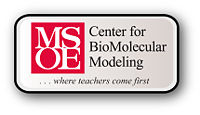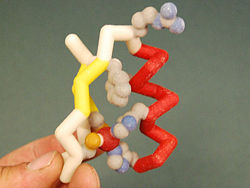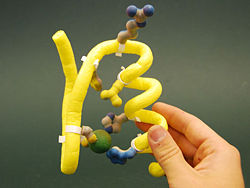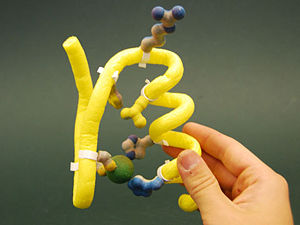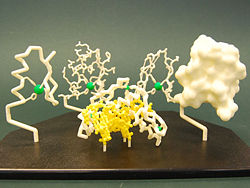Anderson Sandbox
From Proteopedia
A SMART Team Modeling Project from the CBM
This is a Test Series of scenes for
To the right is an image representation of Lac-Y permese of E-coli. The Ligand is shown , the Sidechains Participating in substrate binding are , and residues participating in proton translocation are here.
Function of Lactose Permease
Lactose Permease is a transmembrane protein that facilitates the passage of lactose across the phospholipid bi-layer of the cell membrane. The transport mechanism used is an active co-transport that uses the inwardly directed H+ electrochemical gradient as its driving force. As a result, the lactose is accompanied from the periplasm to the cytoplasm of the cell by an H+ proton.[1]
Lactose is a disaccharide carbohydrate found primarily in mammalian milk. It is a disaccharide composed of the monosaccharides glucose and galactose. When lactose is ingested, it is brought into cells in the digestive system by the protein Lactose Permease. Here it is broken down into its monosaccharide subunits by the enzyme lactase so it may be used in the process of cellular respiration.[2]
|
Highlighting the of the lactose permease protein.
Replace the PDB id after the STRUCTURE_ and after PDB= to load and display another structure.
| |||||||
| {{{CAPTION}}} | |||||||
|---|---|---|---|---|---|---|---|
Different CBM Slogans
The physical models shown on this page were designed and built by the MSOE Center for BioMolecular Modeling. For more information about physical protein modeling, visit the CBM web site at www.rpc.msoe.edu/cbm .
The physical models displayed on this webpage have been designed and build by the MSOE Center for BioMolecular Modeling. To learn more about the CBM and see more examples of protein models, please visit the CBM site at www.rpc.msoe.edu/cbm.
The physical models displayed here are examples of models designed and built by the MSOE Center for BioMolecular Modeling. To see more modeling possibilities and learn more about the CBM, please visit our site at www.rpc.msoe.edu/cbm.
Physical Models
The model shown in Model Image 1 to the left is an example of a physical model of the zinc finger protien. In this representation, the Alpha Helix is shown in Red, the Beta Sheets are displayed in Yellow, and the Residues are represented in CPK color format (O=red, N=blue, C=gray, S=yellow). The Zinc Atom in this structure is colored Red.
The model in Model Image 2 shown to the right is an example of a 'mini-toober' model. The side chains are again displayed in CPK color format. The zinc atom in this example is displayed in green.
MSOE Center for BioMolecular Modeling
The physical models shown on this page were designed and built by the MSOE Center for BioMolecular Modeling. For more information about physical protein modeling, visit the CBM web site at www.rpc.msoe.edu/cbm .
MSOE Center for BioMolecular Modeling
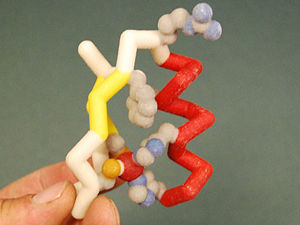
The physical models shown on this page were designed and built by the MSOE Center for BioMolecular Modeling. For more information about physical protein modeling, visit the CBM web site at www.rpc.msoe.edu/cbm .
MSOE Center for BioMolecular Modeling

The physical models shown on this page were designed and built by the MSOE Center for BioMolecular Modeling. For more information about physical protein modeling, visit the CBM web site at www.rpc.msoe.edu/cbm .
MSOE Center for BioMolecular Modeling

The physical models shown on this page were designed and built by the MSOE Center for BioMolecular Modeling. For more information about physical protein modeling, visit the CBM web site at www.rpc.msoe.edu/cbm .
MSOE Center for BioMolecular Modeling

The physical models shown on this page were designed and built by the MSOE Center for BioMolecular Modeling. For more information about physical protein modeling, visit the CBM web site at www.rpc.msoe.edu/cbm .
Physical Models
The model shown in Model Image 1 to the left is an example of a physical model of the zinc finger protien. In this representation, the Alpha Helix is shown in Red, the Beta Sheets are displayed in Yellow, and the Residues are represented in CPK color format (O=red, N=blue, C=gray, S=yellow). The Zinc Atom in this structure is colored Red.
The model in Model Image 2, shown in the center, is an example of a 'mini-toober' model. The side chains are again displayed in CPK color format. The zinc atom in this example is displayed in green.
The models in Model Image 3 are a variety of different representations for the zinc finger molecule. These representations include backbone, wireframe, and spacefill model types.
MSOE Center for BioMolecular Modeling
The physical models shown on this page were designed and built by the MSOE Center for BioMolecular Modeling. For more information about physical protein modeling, visit the CBM web site at www.rpc.msoe.edu/cbm .
